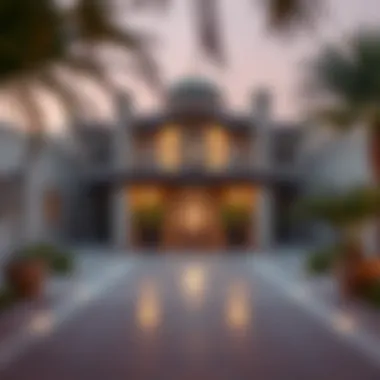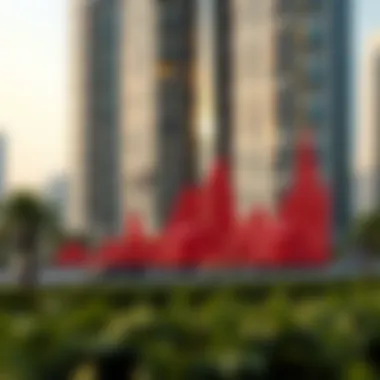Understanding قراط in Dubai's Real Estate Scene


Intro
The landscape of real estate in Dubai is shifting like sands in a desert storm. One of the intriguing concepts intertwining with this dynamic market is قراط, a term that is more than mere nomenclature; it embodies the very notions of land measurement and value in this bustling metropolis. This article will guide you through the intricate ties that قراط has with Dubai’s property scene, serving not only as a valuable metric for investors and homebuyers alike but also as a historical marker of the region's evolving identity.
With real estate in Dubai often considered a goldmine, understanding the role of قراط becomes essential for anyone looking to dive deep into property investments. From current market trends to insights on property types, the significance of قراط can’t be overstated. It’s like the thread that weaves through the fabric of Dubai’s real estate tapestry, affecting everything from buyer decisions to how prices play out on the ground. As we unpack this concept further, we will delve into the distinct neighborhoods, compare property types, and discuss how this land measure intricately informs property valuation and market regulations.
As we venture into market trends, let’s navigate the currents shaping the real estate market, understanding both where we are and where we might be headed.
Understanding قراط
In the context of Dubai's booming real estate landscape, the concept of قراط holds a unique significance. As a unit of measurement that directly impacts property valuation, understanding قراط not only enlightens potential buyers but also equips investors and market analysts to make informed decisions. When talking about real estate, it ain't just about square footage; nuances in measurement can dictate price points, and while buyers might think they’re just paying for four walls and a roof, the value often stems from the land itself, which is quantified by قراط.
Definition and Etymology
The term قراط, derived from Arabic origins, directly translates to “carat,” but its application in real estate is quite distinct. It is a unit of land measurement used predominantly in the Middle East, particularly in Dubai. One قراط is equivalent to approximately 1,000 square feet, although there can be slight variations depending on local customs. This unit is more than just numbers; it encapsulates cultural significance and historical importance in land dealings.
Interestingly, the etymology reflects deeper socio-economic factors and traditional practices of land ownership in the region. In a city like Dubai, where land is both limited and in high demand, comprehending قراط becomes critical in establishing the value and potential of a property.
Historical Context
To trace the roots of قراط, one must delve into Dubai's transformational journey from a modest fishing village to a vibrant metropolis. Historically, land was measured as much by its agricultural value as its potential for development. As Dubai grew, the significance of قراط transcended simple measurement. It morphed into a symbol of prosperity and a yardstick against which investments were gauged. In the 1970s, during the initial waves of real estate development, properties began to be classified and marketed based on their قراط values, allowing for a standardized approach to measuring land in a rapidly evolving market.
In contemporary terms, understanding the historical usage of قراط provides context for its modern-day implications in property transactions. While foreign investors may find the concept slightly bewildering at first, it is critical to recognize that this terminology is second nature to local property players. Effective engagement with the real estate market demands an understanding of these terms that even experienced investors can't afford to overlook. Beyond its numeric value, قراط carries the weight of Dubai's land legacy, influencing everything from heritage sites to skyscrapers.
"In Dubai, knowing the value of land means knowing how to navigate the high-stakes game of real estate." - Local Market Expert
And so, grasping the intricacies of قراط not only aids in understanding property valuation but enhances one's ability to navigate the complex landscape of Dubai's real estate market. As various factors converge, a grasp of this fundamental measurement facilitates more strategic decision-making and investment outcomes.
The Role of قراط in Real Estate
Understanding the role of قراط in real estate is fundamental to navigating Dubai's complex property landscape. This measurement is not merely a number; it’s a critical gauge that reflects both cultural practices and market dynamics. For investors, homebuyers, and real estate analysts, grasping the implications of قراط can lead to more informed decisions, ultimately affecting the bottom line.
Measurement Standards
In Dubai, the قراط is a unit of area particularly relevant in the realm of land and property. Typically defined as equivalent to 1,300 square feet or approximately 120 square meters, this measurement serves as a standard reference for evaluating properties. In a market where every inch counts, understanding the exact quantification of a قراط is crucial for both buyers and sellers alike.
For instance, when evaluating a villa or a commercial space, potential buyers must recognize that the quoting of a property's size in قراط directly influences its perceived value. If a property is listed as spanning five قراط, this translates to around 6,500 square feet. Understanding this measurement not only helps identify suitable properties but also establishes a foundation for price negotiations.
Furthermore, it’s important to note that while the قراط is widely recognized, some foreign investors may be more accustomed to metric or imperial measurements. In such cases, having the ability to convert units effectively can streamline communication and enhance negotiation relations.
The significance of accurate measurements can't be stressed enough; a miscalculation can lead to potentially costly oversights in a buyer's property investment journey.
Implications for Property Valuation
When it comes to property valuation, قراط directly impacts how investors assess potential returns. The intrinsic value of a property often correlates with its size measured in قراط. So, larger plots can command higher market prices based on the premise that they offer more usable area for development or resale.
Consider two properties in the bustling neighborhood of Dubai Marina. Property A, measuring 10 قراط, may be listed for AED 3 million, while Property B, slightly smaller at 8 قراط, is offered at AED 2.5 million. An investor must weigh not only the price but also the overall potential of each property based on its area. This assessment of value is not just about the cramped quarters; it also touches on the property’s zoning regulations, proximity to amenities, and future development plans in the area, which can influence its market value in the long-term.
Moreover, real estate agents pay close attention to قراط when performing comparative market analysis, which is essential for setting accurate listing prices or making competitive offers. Investors should ask themselves: Is the price per قراط competitive with similar properties in the vicinity? This analysis is vital to avoid overpriced investments.


Ultimately, understanding how قراط fits into the bigger picture of property valuation can empower buyers to make decisions that align with their financial goals and risk tolerance.
As the landscape of Dubai's real estate continues to evolve, staying informed about the nuances of قراط can spell the difference between making a savvy investment or falling into pitfalls that others have faced.
Current Trends in Dubai's Real Estate Market
In the fast-evolving landscape of Dubai's real estate market, staying attuned to current trends is not merely beneficial but essential for stakeholders—from investors to agents to buyers. Trends reflect the intricate interplay of economic factors, societal shifts, and the regulations shaping the city’s dynamic property sector. With an ongoing influx of expatriates and an ambitious government vision for urban development, the landscape is quite lively, and understanding these movements can provide strategic insights into the best opportunities.
Market Dynamics
When discussing market dynamics, we must consider the fundamental forces at play. Dubai's real estate market does not operate in isolation; instead, it is influenced by a variety of factors, both domestic and international.
- Supply and Demand: The surge in demand for residential properties can be traced back to the increasing number of expatriates seeking homes in the emirate. Developers are responding with a plethora of new projects aimed at both luxury consumers and mid-range buyers. This ongoing construction affects availability, price points, and ultimately, the perceived value of the قراط.
- Economic Indicators: As the emirate diversifies its economy beyond oil dependency, sectors such as tourism, finance, and tech are on the rise. Increased job opportunities help bolster the rental market, making properties in sought-after areas more attractive.
- Regulatory Changes: Shifting laws and policies also impact market dynamics. For instance, introducing long-term visas for skilled workers has led to considerable investment and interest in residential properties.
A closer look at these dynamics reveals that investors must stay vigilant, continually assessing how external factors can influence their investments in terms of both risk and reward.
Investor Behavior
Investor behavior in Dubai's real estate sector reflects changing sentiments and market reactions to outside forces. With high-value investments on the line, understanding how investors are responding to current conditions is key.
- Risk Appetite: Following the global economic downturns, there is a noticeable shift in the risk appetite of investors. Many are leaning towards properties that promise stable rental yields or capital appreciation. Investors are becoming savvy, seeking out properties that not only meet their immediate needs but also their long-term financial goals.
- Interest in Sustainability: More investors are leaning toward sustainable and eco-friendly developments, driven by a blend of personal values and market demands. Properties that prioritize environmental responsibility often see enhanced value, reflecting in demand rankings in terms of قراط.
- Diverse Portfolio Perspectives: With the market opening doors to a wider range of property types, from luxury apartments to commercial spaces, investors are diversifying their holdings. This diversification is not only a protective strategy, but it indicates their recognition of the multifaceted nature of the Dubai real estate market.
"Understanding current trends is like reading the signs of the times. Those who heed these signs often find themselves on the right side of opportunities."
In summary, the exploration of market dynamics and the behaviors of investors reveals a landscape ripe with opportunity and riddled with complexity. For those engaged in Dubai’s real estate scene, the key lies in balancing caution with proactive investment strategies, always keeping one eye on the changing tides.
Potential Buyers and Investors
In the sprawling landscape of Dubai's real estate sector, where the skyline reflects a blend of ambition and innovation, potential buyers and investors find themselves at a crucial juncture. This part of the article emphasizes the significance of understanding the dynamics surrounding قراط—both as a measurement tool and a conceptual framework for investment. Navigating this intricate market requires a keen focus on specific elements, benefits, and considerations vital to making informed decisions.
The influx of a diverse demographic, fueled by economic growth and global legitimization of property ownership in Dubai, necessitates a nuanced appreciation of what buyers and investors need. As the market continually adapts to regulatory changes and shifting economic trends, a comprehensive understanding of these needs ensures that prospective buyers can maximize their investment potential while mitigating possible risks.
Understanding Market Needs
Identifying what buyers require is essential for harmonizing the preferences of end-users with the targets of investors. This understanding goes beyond merely grasping what properties are available. For instance, consider the demand for sustainable developments and smart homes that cater to eco-conscious consumers. The rise in interest for green spaces or properties with amenities like gyms and pools represents a critical shift in buyer expectations.
Main needs that buyers articulate often include:
- Affordability of properties and associated costs
- Proximity to essential services like schools, hospitals, and public transport
- Availability of quality construction and modern amenities
- Reputable developers with a good track record
This insight plays a crucial role in how investors shape their portfolios, allowing them to align their investments with market demand. Failure to assess these needs can lead to investments in properties that may retake a windfall return on investment.
Strategies for Effective Investment
Navigating the Dubai real estate landscape effectively means adopting strategic approaches towards investment. A key aspect of this includes choosing between long-term and short-term investment strategies. Each route offers unique characteristics and potential outcomes that contribute to the overall goal of maximizing returns in a competitive market.
Long-term vs Short-term Investment
Evaluating the benefits of long-term versus short-term investments can be a game changer. Long-term investments typically involve acquiring properties with the intent of holding them for extended periods. This strategy capitalizes on property value appreciation over time, thus providing stability against market volatility. Investors can build wealth and contribute positively to sustained rental income streams.
On the other hand, short-term investments focus on flipping properties or capitalizing on rapid market movements. Though potentially lucrative, they come with heightened risks due to market fluctuations. Buyers who lean toward this strategy must act decisively and remain highly informed about market trends and buyer behavior.


In summary, the distinct characteristics of long-term investments include:
- Steady cash flow from rental income
- Lower risk due to market stabilization over time
- Value appreciation leading to higher selling prices in the future
Conversely, features of short-term investments encompass:
- Quick returns through property flipping
- Exposure to market volatility, necessitating dynamic decision-making
- Higher initial costs for fast renovations or alterations
Identifying Lucrative Properties
Another pivotal consideration for potential buyers and investors is the process of identifying lucrative properties. Given the competitive nature of Dubai's real estate sector, having a knack for recognizing properties with strong investment potential becomes a valuable skill. This entails assessing emerging neighborhoods, properties with unique selling propositions, and analyzing trends for future growth areas.
Key characteristics to identify include:
- Location in proximity to key infrastructural projects or upcoming developments
- Historical performance in property value appreciation within certain areas
- Rental yield percentages that indicate potential income returns
Understanding the unique features of lucrative properties empowers buyers to make informed investments. Regions that exhibit significant development plans or align with tourism trends can often provide better opportunities for growth and rental income.
Ultimately, while venturing into Dubai's real estate market, it's vital to approach potential investments with strategic awareness and an understanding of target markets. By harnessing insights about buyer needs, choosing appropriate investment strategies, and identifying promising properties, investors can carve out a path toward financial viability and success.
Regulatory Framework in Dubai
In the rapidly evolving landscape of Dubai's real estate market, understanding the regulatory framework is crucial for investors, homebuyers, and agents alike. The regulations not only dictate the legal standing of property ownership but also guide the entire process of real estate transactions. As a hub for global investment, Dubai has established a robust legal structure that aims to protect parties involved while attracting foreign investment. This framework is designed to ensure transparency, promote fair practices, and enhance investors' confidence in making decisions.
Land Ownership Laws
The laws surrounding land ownership in Dubai are distinctly unique when compared to many other countries. Foreigners can own property in designated freehold areas, which significantly broadens the scope for investment opportunities. Some key aspects of the land ownership laws include:
- Freehold vs. Leasehold: In freehold areas, non-UAE nationals have full ownership rights, while in leasehold properties, ownership is limited to 99 years. This distinction is vital for prospective buyers needing to understand their long-term investment potential.
- Types of Ownership: Property ownership can be categorized into various types such as residential, commercial, and industrial, with each having its own set of regulations and restrictions.
- Title Deeds: Upon purchasing property, buyers receive title deeds issued by the Dubai Land Department. This document is essential as it serves as proof of ownership and must be verified when any transfer occurs.
Understanding these laws is indispensable for navigating the market effectively, ensuring that investors are making sound choices based on their financial goals.
Compliance and Regulation
Navigating the compliance landscape in Dubai's real estate sector involves adhering to a myriad of regulations set forth by governmental agencies. This compliance is not just a legal requirement; it also enhances the integrity of the market. Important elements include:
- Real Estate Regulatory Agency (RERA): RERA plays a pivotal role in overseeing the real estate sector in Dubai. It sets guidelines that govern the practices of developers, ensuring that projects are delivered in accordance with agreed terms. Buyers must ensure that their transactions comply with RERA's stipulations.
- Official Documentation: All property transactions must be documented properly to comply with Dubai law. This includes contracts, agreements, and certification of property purchases.
- Sustainability and Best Practices: Increasingly, regulations are focusing on sustainability and ensuring that developers adhere to environmental standards. This highlights Dubai's commitment to future-proofing its real estate sector and attracting environmentally conscious investors.
"Navigating the regulatory landscape of Dubai's real estate is not just about following laws; it's about ensuring the longevity of your investment."
Challenges in the Real Estate Market
In any bustling real estate environment like Dubai, challenges are as commonplace as the luxurious skyscrapers that define its skyline. Understanding these challenges is pivotal for investors, homebuyers, and analysts alike. Amongst these challenges, market volatility and legal barriers emerge as critical elements that can significantly impact decision making and investment strategies. With this understanding, parties interested in the Dubai real estate market can better navigate the complexities that lie ahead.
Market Volatility
Market volatility in Dubai's real estate sector often feels like a double-edged sword. On one hand, the quick shifts in property values can present golden opportunities for savvy investors, while on the other, they pose considerable risks. Recent trends show that the market can swing from a booming property market to a cooling phase within a short period, influenced by factors like global economic conditions, changes in oil prices, and even shifts in government policy.
Here are key elements that highlight the impact of market volatility:


- Fluctuating Prices: Property prices can rise or fall dramatically in a matter of months, creating uncertainty in investment returns.
- Buyer Sentiment: Emotional responses to market conditions can lead to panic selling or over-enthusiastic buying.
- Investment Strategy: Investors need to adopt flexible strategies, keeping an eye on market trends and adjusting their approach accordingly.
"Being watchful in a volatile market means the difference between loss and opportunity."
Having a grasp on these market movements can help potential buyers and investors avoid missteps and capitalize on advantageous moments when the circumstances favor their purchasing decisions.
Legal Barriers
Navigating the legal landscape in Dubai’s real estate market can feel like taking a stroll through a maze. Various laws and regulations govern land ownership and property transactions, and unfamiliarity can lead to costly setbacks. Legal barriers can deter both local and foreign investors, making it imperative to understand them thoroughly.
- Ownership Laws: In Dubai, certain areas are designated for foreign ownership, while others remain restricted. Without knowledge of these zones, buyers may face legal hurdles that limit their options.
- Regulatory Compliance: Specific compliance protocols must be adhered to, from documentation to the processes involved in property registration. Non-compliance can result in fines or even the annulment of agreements.
- Investor Rights: It's crucial for investors to be aware of their rights and obligations under the law, as ignorance can lead to disputes and potential losses.
In this context, collaborating with real estate professionals who are well-versed in local laws can significantly mitigate legal risks and enhance confidence in transactions.
By acknowledging the challenges of market volatility and legal barriers, investors, buyers, and analysts can forge their plans more effectively. Emphasis on acquiring accurate information and adapting strategies in a fast-paced environment ensures that they remain one step ahead in Dubai's vibrant real estate landscape.
Future Outlook of قراط in Dubai
The exploration of قراط in the context of Dubai's real estate market holds immense weight for various stakeholders, including investors and homebuyers. As this intermingling of history and contemporary practice shapes the landscape, understanding future prospects is essential. The trajectory of property values, investment opportunities, and broader market dynamics all hinge on the evolution of قراط.
Predictions for Property Values
As Dubai’s skyline continues to rise, so does the complexity of its property market. Over the past few years, data shows a notable increase in property values, but predicting future trends requires insightful analysis. Factors such as supply and demand, economic conditions, and overarching government regulations play a crucial role.
- With properties being sold per قراط, fluctuations in value can be anticipated based on land release policies and urban planning.
- For instance, recent initiatives from the Dubai Land Department show efforts to streamline processes, which could lead to increased property appreciation rates.
One aspect that stands out is the expected increase in demand for residential and commercial spaces. Given the global trend toward investment in emerging markets, property values in Dubai might see a steady upward trajectory. An accumulating infrastructure, like the expanding metro lines and developments near tourist attractions, can further enhance property attractiveness. Buyers and investors need to stay attuned to these market signals as they could prompt strategic decisions.
Investment Opportunities
The dynamic nature of قراط in Dubai opens a wealth of investment avenues. Investors looking to capitalize on this valuable knowledge can position themselves advantageously by recognizing key trends and the nature of the market. Here are some investment considerations:
- Diversification: Exploring varied types of properties can help mitigate risks. From high-end luxury apartments in Downtown Dubai to affordable housing in emerging neighborhoods, the potential for returns is vast.
- Joint Ventures: Partnering with local developers familiar with the regulatory landscape can ease entry into Dubai's marketplace and pave the way for fruitful ventures.
- Focus on Green Developments: Current shifts in consumer awareness towards sustainability mean properties focused on eco-friendliness are likely to garner attention. A focus on developments adhering to sustainable practices can ensure long-term value retention.
As the influx of foreign investments continues, market observers should keenly monitor shifts in projections. The intersection of قراط with emerging real estate trends marks a space ripe for exploration.
Epilogue
The conclusion brings forth a tapestry woven from the intricate threads of قراط's significance within Dubai's ever-evolving real estate landscape. By digging into what قراط represents—both as a unit of measurement and a cultural touchstone—readers gain more than just insight into property evaluation; they gain an understanding of the very soul of Dubai's real estate market. This chapter is paramount as it recaps critical elements discussed throughout the article while also nudging the reader to contemplate the implications of this knowledge in practical terms.
Recap of Key Insights
Reflecting back on what has been traversed, several crucial insights emerge:
- Definition and Etymology of قراط: Understanding its roots illustrates how cultural context shapes current valuation methods.
- Role in Real Estate: The nuances of measurement standards underline why comprehending the concept is vital for buyers and sellers alike.
- Market Dynamics: Recognizing current trends helps potential investors position themselves strategically.
- Regulatory Framework: Familiarity with laws governing property ownership in Dubai is non-negotiable. An informed buyer is a powerful buyer.
- Challenges Ahead: Acknowledging market volatility prepares both investors and buyers to be more resilient.
This summary serves not just as a reiteration of facts but as a guidepost, encouraging stakeholders to navigate through complexities with confidence and clarity.
Final Thoughts on قراط and Real Estate in Dubai
As we wrap up this exploration, it's essential to highlight that قراط is not merely a word or a measurement; it encapsulates the essence of property dealings in Dubai. Buyers look for assurance that their investments hold water, while sellers want to grasp how market fluctuations influence their assets.
In this high-stakes environment, an understanding of قراط can make all the difference. Whether you are an investor eyeing a luxurious villa in Palm Jumeirah or a first-time homebuyer looking to settle in Dubai Marina, the impact of قراط extends far beyond mere numbers on a contract. It reflects a system embracing change yet anchored in tradition.
As Dubai continues to attract a myriad of buyers and investors from all corners of the globe, the necessity for clarity and strategic planning becomes even more pressing. In a city that thrives on ambition, knowing how to measure your assets precisely can convert a dream into reality.
Keep in mind that every investment carries its own set of risks and rewards. However, those well-armed with knowledge of قراط will navigate the waters of this dynamic market with a greater sense of assurance, understanding, and anticipation for what the future holds.















